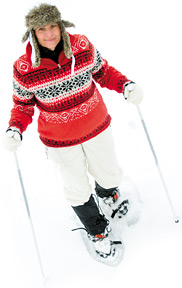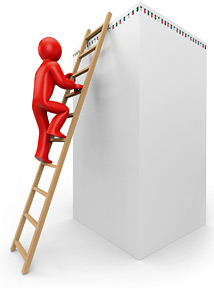When you lift something, try this little trick beforehand and use your muscles to full advantage. Imagine yourself sitting back and down on a toilet seat. Yes, you read that right, a toilet seat.
Sit back and down as you bend. This motion hinges your hip joints backward so you sit back into the lift, rather than bending forward over the waistline, significantly reducing the pressure on your low back and transferring it to the powerful hips.
When you rise up from the bottom position of a lift, use the power of your hip, buttock and leg base instead of the weakest link in the low back. Almost all low back injuries occur from dysfunctional movement at the hip joints. The low back simply overworks and becomes fatigued, increasing the likelihood of injury. Next time you go for that toy, remember to "sit back on the seat" and lift with your tush.
Slippery Slopes Will Get You Every Time
 Depending on your geographical location, snow and ice may or may not be an issue for you this holiday season. If you have ever experienced the wonderful "black ice" shuffle, you know what it means to be vulnerable to the elements. Countless individuals are injured every year from icy sidewalks, stairs, roads and parking lots. You never know when and if it will happen to you. When it does, all you can do is hold on for the ride, right? Wrong! You can actually do proprioceptive training movements to enhance your stability and balance.
Depending on your geographical location, snow and ice may or may not be an issue for you this holiday season. If you have ever experienced the wonderful "black ice" shuffle, you know what it means to be vulnerable to the elements. Countless individuals are injured every year from icy sidewalks, stairs, roads and parking lots. You never know when and if it will happen to you. When it does, all you can do is hold on for the ride, right? Wrong! You can actually do proprioceptive training movements to enhance your stability and balance.
Proprioception is simply your body's ability recognize and adapt to positional changes for balance and control. So, even if you don't live in an icy, cold environment, these movements help prevent injury in case of a trip or fall. The first strategy is to expect the unexpected. Become aware of your surroundings and become very intent with every movement. In other words, concentrate on your environment!
Doing balance exercises is a great way to prevent falls. One of the main causes of injury is an asymmetry in movement from one side of the body to the other; that means you can do something better on one side than the other. Practice single-leg balancing to enhance symmetry from the left side to the right side. Stand with your bare feet together. Raise one leg up to waist height, bending at the knee with a tall spine (reaching the head toward the ceiling) and attempt to balance for 10 seconds. Repeat on the opposite side. Do you feel a difference? If so, you need to practice this maneuver until you become equally skilled on both sides.
Once you master this equally on both sides for 10 seconds each, attempt it with eyes closed. This is more challenging, so be prepared to open your eyes or grab something for stability until you feel comfortable.
In the event that you do slip or fall, it is important to learn the proper way to fall. Knowing how to fall or how to "break your fall" is crucial to lessening impact injuries. Many severe injuries can be avoided if you understand how to land so that the body properly absorbs the shock.
Keep your head up. This is the most important location of the body that you do not want to damage. You do not want to have your head connect with the ground. It is better to bruise your arms than to bruise your head. Slap your palms off the ground if falling forward. Make sure your whole palm slaps the ground. This is done only for a second to slow your fall slightly and prevent breaking your wrists. It is not meant to absorb all of your weight or "catch" you. Remember not to lock your elbows.
 If falling from a height, roll as you hit the ground. This will distribute the force of the impact throughout your body, instead of just on one place. If falling backwards, try to bend at the knees and squat before the fall. Curl your back and roll on it. Don't try to break the fall with your arms. Lower your center of gravity as much as possible to lessen the distance to the ground.
If falling from a height, roll as you hit the ground. This will distribute the force of the impact throughout your body, instead of just on one place. If falling backwards, try to bend at the knees and squat before the fall. Curl your back and roll on it. Don't try to break the fall with your arms. Lower your center of gravity as much as possible to lessen the distance to the ground.
It's A Long Way Down From Up There
Climbing up ladders or standing on stools/chairs to hang lights and decorations can be a dangerous adventure. You don't want to have a Clark Griswald "Christmas Vacation" moment. Take special care to ensure all ladders are functioning properly and you have a "safety spotter" to help in stabilizing any device you are standing on. Chairs can slip or break and ladders can fall. Equilibrium is affected when you are higher off the ground and your sense of proprioception is altered. What your brain interprets as distance is often incorrect. Do due diligence to move slowly and intently on platforms with limited foot space.

